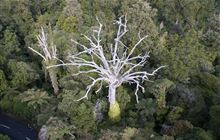Goldie Bush Reserve tracks re-opening
Archived content: This media release was accurate on the date of publication.
Introduction
DOC is re-opening all tracks in Goldie Bush Scenic Reserve in the Waitakere Ranges following an extensive track upgrade to prevent the spread of kauri dieback.Date: 18 October 2018
DOC is re-opening all tracks in Goldie Bush Scenic Reserve in the Waitakere Ranges today (Thursday October 18) following an extensive track upgrade to prevent the spread of kauri dieback.
As a further measure to protect kauri, a Controlled Area Notice (CAN) has been placed on the Goldie Bush reserve and tracks.
The CAN means anyone entering the Goldie Bush tracks must ensure there is no visible soil on their footwear, or any item they’re carrying, when they enter and leave the tracks. They must also stay on the tracks.
Three new walk-through cleaning stations have been installed at track entrances so people can clean and disinfect their footwear and items they’re carrying when entering and leaving the tracks.
Anyone who does not use the cleaning stations may be prosecuted under the Biosecurity Act 1993. Anyone who enters or leaves the tracks with visible soil on their footwear or any item they’re carrying may also be prosecuted.
“The CAN is well sign posted and track ambassadors will be stationed at the cleaning stations throughout summer, from Labour Day Weekend,” says DOC Auckland Mainland Operations Manager Kirsty Prior.
“The track ambassadors will ensure people are using the stations properly and complying with the CAN.”
DOC closed the Goldie Bush tracks on March 18 after consulting Te Kawerau ā Maki about the rāhui to protect kauri in the Waitakere Ranges.
The rāhui covers the forested area largely contained within the Waitakere Ranges Heritage Area. Goldie Bush is north of the Heritage Area but DOC supported the rāhui through track closures while undertaking further consultation with Te Kawerau ā Maki.
“Since 2009 we’ve done a lot of work on the Goldie Bush tracks as part of DOC’s programme to prevent the spread of kauri dieback,” says Kirsty Prior.
“Prior to the March closure we installed sections of board walk, the Geoweb track surface system and spread stone chips to eliminate muddy sections of track. We also diverted water runoff away from kauri."
“Since the closure we’ve added the three walk-through cleaning stations, installed further drainage and spread approximately 1.5 km of stone chips to ensure the tracks are ready.”
“We’ve been working closely with Te Kawerau ā Maki and as a result, we now have a more robust track, with stronger enforcement in place, better information and great interpretation.”
“This upgrade work will ensure the tracks stay mud-free in all conditions and keep kauri safe.”
"Kauri are amongst the world's mightiest and longest-living trees. They create shelter and nourishment for other species to grow and are a cornerstone of the forest. When kauri disappear, the kauri forest goes too.”
"There's currently no proven cure or treatment for kauri dieback. We can only save kauri by stopping it spreading from infected areas. We need everyone to play their part to help save kauri for future generations," says Kirsty Prior.
Contact
For media enquiries contact:
Email: media@doc.govt.nz


